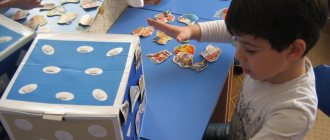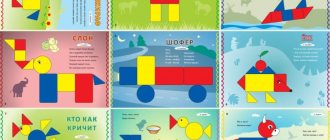Didactic games in fine arts in the preparatory group
When preparing kindergarteners for school, it is important to teach them to describe pictures and their feelings from what they see, to show imagination in everyday life, to be attentive and observant
Guess the picture
For the game, prepare reproductions of paintings familiar to kindergarteners. Describe each image verbally and let the children guess what it is about. For example: “In a bright room, a girl in a pink jacket is sitting at a table, she has a fruit in her hands” - this is “Girl with Peaches” by Valentin Serov. Or: “A mother bear and three cubs are frolicking on fallen trees in the middle of a pine forest” - this is “Morning in a Pine Forest” by Ivan Shishkin.
Guess by profile
Prepare recognizable contour profiles of fairy-tale characters: Baba Yaga, Kashchei, the Little Humpbacked Horse, the Serpent Gorynych and others. Children must guess who is pictured.
What does the painting smell like?
Show your students reproductions of paintings. Let them imagine what smells they will smell when they suddenly find themselves inside the painting.
How does the picture sound?
The game is similar to the previous one, only here they imagine not by smell, but by hearing. Let the children imagine what sounds they will hear when they are inside the painting.
What do clouds look like?
If the weather and sky conditions permit, take the group for a walk. If not, find beautiful photos of cumulus clouds. Invite students to imagine what they look like. Emphasize that clouds come in different shapes and sizes.
What's missing?
Show the children some reproductions of famous paintings. Cover up any detail in the images. Show the pictures again and ask them to remember which element is hidden.
Portrait of a neighbor
The game teaches you to correctly and correctly describe a person.
Give participants cardboard frames. Let everyone, bringing the frame closer to their neighbor’s face, try to create a verbal portrait of him.
Didactic games in fine arts in the senior group
In classes with older preschoolers, it is worth paying attention to the emotional side of fine art, developing an understanding of the genres of painting, and developing the skill of constructing a composition
Draw a portrait
To play, draw 4-5 portraits depicting human emotions: joy, fear, surprise, sadness, anger. Cut the images into 3 parts: forehead and eyes, nose, mouth and chin. For clarity, show several famous painting portraits. Explain what genre this is. Invite participants to become artists and create portraits with different emotions from parts of the face.
Make up a landscape
Place cards on the table depicting various objects of the surrounding world. Ask to choose those from which you can make a landscape.
Collect a still life
Cut out pictures of fruits, vegetables, berries, flowers, mushrooms, vases, baskets, jugs. Ask the children to create a beautiful still life.
Happy or sad
Like the didactic game “Artist,” this activity teaches you to correlate mood with palette.
As visual material, use realistic illustrations from books and reproductions of famous paintings. Show the image to your students and ask them to determine what mood it conveys and why. Children should explain that fun is reflected in bright, rich, light colors, and sadness is reflected in dull, dark, dull colors.
Sea
The game teaches you how to build an artistic composition and develops logical thinking.
Prepare a picture of an empty sea with a background of seaweed and a sandy bottom. Separately depict underwater inhabitants: fish, snails, shells, dolphin, whale, seahorse and others. Explain to the participants that the sea inhabitants hid. To see them, you need to solve riddles. A child who correctly guesses a living creature attaches its picture to the underwater landscape.
What will happen?
Place a piece of paper and pencils in front of the players. Children take turns drawing. One draws a line and gives the sheet to the other participant. He continues the drawing with the second line and passes the baton. And so on until the drawing is ready. At the end, everyone looks at what happened.
What doesn't happen?
Offer kindergarteners a game to develop their imagination. Let them draw something that does not exist. Each participant demonstrates his creation and explains what he depicted. The others discuss whether there really is no such object in the world.
Didactic games in fine arts in the middle group
For older children, offer games to develop color vision and imagination, the ability to understand the mood of a picture, compose figures and patterns in compliance with symmetry and spatial relationships.
Cheerful caterpillar
Make circles in different shades. Tasks for children - to make caterpillars from circles in different variations:
- from dark to light shades;
- from cold to warm.
Colorful arithmetic
The circles used for the previous game can be used for another activity that develops color perception. Additionally, draw arithmetic signs: plus, minus, equal. Make the circles in different ways, and the students must guess what shade they will get.
For example:
- red + yellow = orange;
- green – yellow = blue;
- blue + white = light blue.
Palette
Paint the seasons using 4 separate palettes. Place landscapes (autumn, winter, spring, summer) in front of the students. Showcase the palettes you used. The task is to determine by the combination of colors what palette each landscape was painted with.
Bunny
The game develops imagination. Children learn schematic representations of living beings.
For this lesson you will need ovals of different sizes and elongations cut out of cardboard. Invite the players to create a bunny standing on its hind legs from the available figures. If desired, let the children try to place other animals.
Decorate your mitten
The game teaches how to create patterns taking into account spatial relationships and symmetry. Place a mitten cut out of paper and a set of geometric shapes in front of your child. The task is to create a beautiful and symmetrical pattern.
Playing in visual arts can instill the skill of cooperation and interaction. To do this, divide the kindergarteners into pairs and distribute mittens: one with the right one, the other with the left. Let them try to make the same patterns.
Plasticine vase
Let the child connect 2-3 small pieces of plasticine of different shades and knead them well to obtain streaks reminiscent of marble. From the resulting mass he will fashion a vase.
Magic palette
The game develops the perception of the colors of the surrounding world and an emotional response to the beauty of nature.
Give participants square colored cards. Name a natural object. Children must remember how it is colored and pick up the corresponding cards. For example, with the word “birch”, white, black, green squares should be raised. When you hear the word “chamomile” – yellow, white, green. The participant who picks up the wrong card is eliminated.
Painted horses
The game reinforces the idea of the main types of Russian folk paintings.
Prepare painted horses and images of four pastures called “Gzhel”, “Dymka”, “Gorodets”, “Filimonovo”. The child must say what painting each figurine is decorated with and place it in the corresponding pasture.





